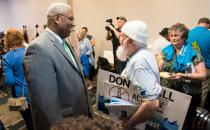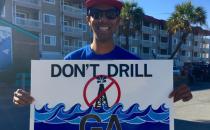Federal officials getting an earful on offshore drilling as comment period ends
As the public comment period for the Trump administration’s offshore drilling plan comes to a close this Friday and the Bureau of Ocean Energy Management (BOEM) public listening sessions wrap up, the window is closing to let officials know the East Coast is not interested in trading resorts for refineries. Comments can be submitted via protectourcoastnow.com.
Meanwhile the recent round of public meetings held by BOEM are drawing criticism from elected leaders and coastal communities across the Southeast. Rather than engage with affected communities, the meetings were held only in state capitols – often hundreds of miles from the coast—and in locations that were difficult for people to access. For those able to attend, the hearings offered little opportunity for people to get their questions answered and no opportunities for public testimony. BOEM officials have rejected repeated calls from state leaders, even officials who support drilling, to hold public hearings closer to coastal communities.
As the end of the comment period approaches, SELC launched an new interactive tool that explores the many impacts of the proposed drilling plan for the Mid- and South Atlantic through story maps, showing what’s at stake for communities, key resources, economies, and quality of life along our coast and how these factors overlap and interplay.
One layer of the map highlights the numerous sensitive habitats in the area under consideration for drilling. The next expected development will be the federal government issuing draft permits for seismic testing, the first step toward allowing oil and gas exploration. Seismic testing requires blasting massive sonic booms from a boat to the ocean floor as companies try to determine where to drill. SELC and our partners are busy preparing our response to remind federal officials, again, of the many reasons we opposed similar previous permits, most notably the impact on marine mammals and key east coast fisheries.


